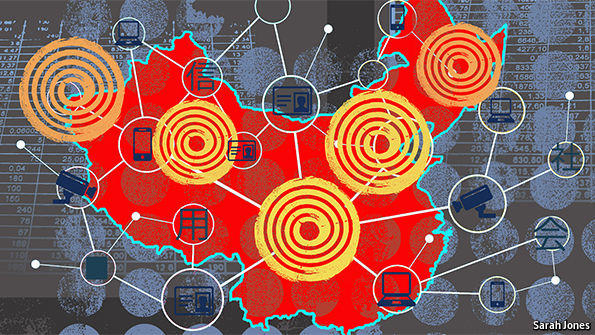Digital Technologies
We study digital initiatives in a variety of sectors, including health care, environment, traffic, and security. We specifically focus also on a number of key technologies and digital themes: facial recognition technologies, social credit systems, and contact tracing apps.
Facial Recognition Technologies
Facial Recognition
Image Credit: "Facial Recognition" by mikemacmarketing is licensed under CC BY 2.0
Facial recognition technology (FRT) — which seeks to match people from a digital image or video with various identifying attributes — is increasingly commonplace and the subject of increased debate. On one hand, FRT is seen as a potentially powerful instrument for law enforcement and commercial interests. Government applications of FRT are wide-ranging, including for improved security in schools and airports, location of missing people, detection of rare, fighting against crime and corruption, paying out pensions, imposing age restrictions on online viewing of pornography and limiting gambling addiction. At the same time, FRT poses ethical dilemmas, since the technology is subject to biases, remains prone to inaccuracies, and can intrude on privacy when used clandestinely. The promised benefits of FRT applications come with trade-offs regarding digital mass surveillance, discrimination, privacy intrusion, as well as infringement on human rights. As a multi-purpose tool, the same underlying technology thus helps people and save lives and can also horrify individuals and pose ethical conundrums. In our project we study how the technology is employed in China and assess public attitudes toward FRT.
For further readings:
- On public opinon on FRT, see our study.
Social Credit Systems
Big Data
Image Credit: Sarah Jones (CC0 1.0)
A variety of commercial and local government Social Credit Systems (SCSs) are now being implemented in China in order to steer the behavior of Chinese individuals, businesses, social organizations and government agencies. Previous studies have looked at SCS in general (Creemers, 2018) or studied public attitudes of SCS (Kostka, 2019) and behavioral responses, (Kostka and Antoine, 2020). The Chinese government with its control of state media has a powerful instrument with which to maintain positive impressions of SCSs. We study if and to what extend Chinese state media has painted a rosy picture about the SCSs, issue framing that our previous analysis suggests has been quite successful.
For further readings:
- On information control, see our study.
Contact Tracing Apps
Covid App
Image Credit: Bild von Markus Winkler auf Pixaby
The adoption of COVID-19 Contact Tracing Apps (CTAs) has been proposed as an important measure to contain the spread of COVID-19. China was the first country to introduce a CTA as a means of curbing the spread of the virus, rolling out its ‘health code’ app nationwide in February 2020. The app was developed by internet giants Alibaba and Tencentand made accessible to users through Alipayor WeChat using their phone number, full name, and government ID number. Anecdotal evidence suggests that most Chinese citizens quickly embraced the app and it received much praiseon the microblogging platform Weibo for tracing contacts with infected persons (Jao, 2020). However, due to the rapid implementation, various complaints emerged over time, including mistaken color codes, potential discrimination, privacy violation, and data security concerns (Feng, 2020; Guo, 2020; Yeet al., 2020). Privacy concerns also increased when the city government of Hangzhou announced it would‘normalize’the health code practice by transforming the health code into a permanent health index app (Du, 2020). This discussion illustrates that public opinion in China can at times be critical, and in research we use online surveys and interviews to better understand citizens’ concerns and preference.
For further readings, see our study.



